Guatemalan fruits are known for their juicy, succulent, and sumptuous tropical flavor. With a wide variety of fruits, from drupe fruits to berries, the Guatemalan people are never in a shortage of fruity delights.
Below are some of the most common and tastiest fruits you can find in Guatemala in almost every season. You may already find some of these familiar as they are present in your daily diets. However, there are some types I’m sure you have never heard of.
Therefore, it is only fair you read through this article to know what fruit you should look for on your next trip to Guatemala. If you love the exotic foods from Guatemala, you will enjoy the country’s fruits, too. In case you’re not, let’s learn about them anyway because they are awesome!

16 Seasonal Guatemalan Fruits Available For A Limited Time
There are so many delicious fruits that you can only find in particular months of the year. The same case goes for Guatemala, where certain exotic fruits are only available for a limited amount of time. Let’s see what they are!
1. Guanábana/Graviola (Soursop)
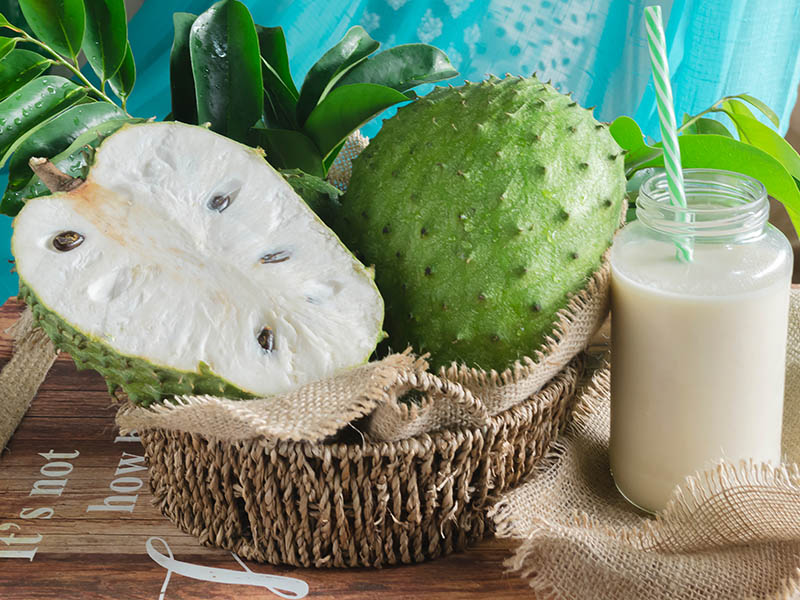
Guanábana is a fruit with a green and spiky facade. It comes from Annona Muricata, a broad-leaf evergreen tree, which is present in most American regions, especially in Guatemala.
Graviola is also known as Soursop. The reason for this name is the fruit’s acidic taste when it ripens. Some people describe the taste as a combination of strawberries and apples, with a smooth custard texture like bananas.
Nowadays, soursops are among the favorite fruits in Indian and other regions. But they were only native to the soil of Guatemala and other Caribbean countries.
Season: Early summer to mid-fall is the time you’ll be able to find Graviolas the easiest in Guatemala.
Healthy nutrients: Graviolas are packed with vitamin B1, vitamin B2, vitamin C, Iron, and Zinc.
How to eat: Peel the skin and remove the seeds. You can eat the flesh chilled or blend it into a smoothie to enjoy.
2. Jocote De Marañon (Cashew Fruit)

Jocote De Marañon is a seasonal fruit in Guatemala. It also goes by the name Marañon or the English name, cashew apple, or cashew fruit. If you have the chance to visit the markets of Guatemala, this fruit will surely catch your attention.
This fruit grows abundantly all over Central America, the Caribbean, and parts of South America (especially Brazil – its place of origin). Along with the nuts, Guatemalan people also enjoy eating the sweet and slightly tangy fruit of cashews.
Now there are two parts to the cashew fruit. The upper part is the cashew nut, a very familiar ingredient in your daily diet. The lower part, which is the cashew apple, is a lesser-known edible fruit, which is delicious yet very quick to spoil.
Be careful when eating this fruit because it contains urushiol, a toxin that creates a dry feeling in your mouth or an itchy rash on your skin, especially the nut part.
Season: Jocote de Marañon is available and the tastiest during the months of spring.
Nutrients: Cashew fruits help reduce blood pressure and enhance heart health. They also include nutrients like copper, magnesium, and zinc.
How to eat: For the cashew apple, you can peel the skin and slice them into thin slices before eating. You can also eat the cashew nut, either boiled or roasted. Cashew nuts can also be used to make cashew butter.
3. Jocote (Hog Plum)
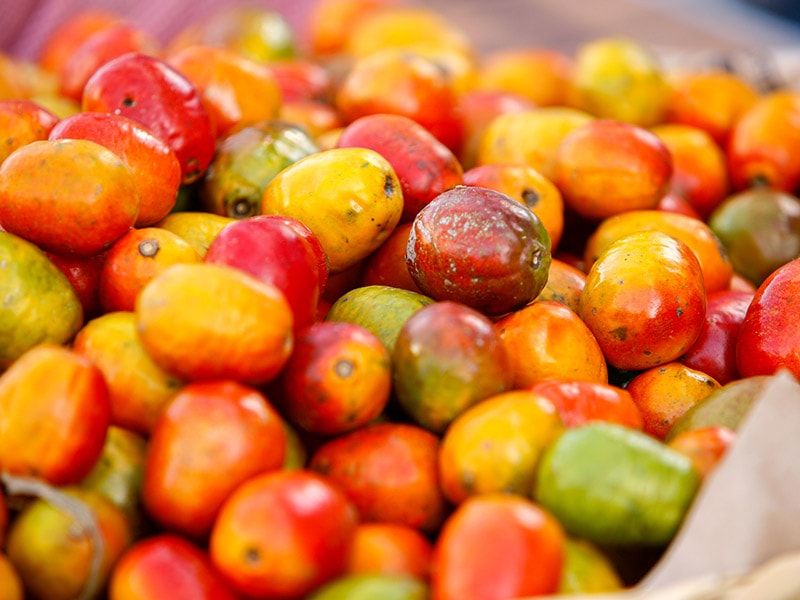
Despite the small size, jocote plums are the kind of fruit that will flood your palate with flavors right at the first bite. This cashew-family fruit tree grows wild in the area that runs from southern Mexico to northern Peru.
Nowadays, the most popular destinations to enjoy this fruit are Guatemala and a few other countries like Honduras and Panama.
The jocote fruit is one you can enjoy at any time during its maturing process. Depending on the ripening stage, the taste of this fruit will vary. A ripe jocote fruit will give you a sweet and citrusy taste, whereas an unripe one will rush through your palate with an extremely tart flavor.
jocote is something that Central Americans, namely Guatemalans, have been using as food and medicine for a long time. Aside from the fruit, Guatemalans also use the sap from the jocote tree together with pineapple to treat symptoms of jaundice.
Season: Usually during the rainy season, from July to October
Healthy nutrients: Vitamin C, Iron, Potassium, Fiber.
How to eat: You can eat jocote fresh or press it into juice. Moreover, you can also cook jocote into a type of syrup that makes a delicious ice cream topping.
4. Granadilla (Sweet Passionfruit)
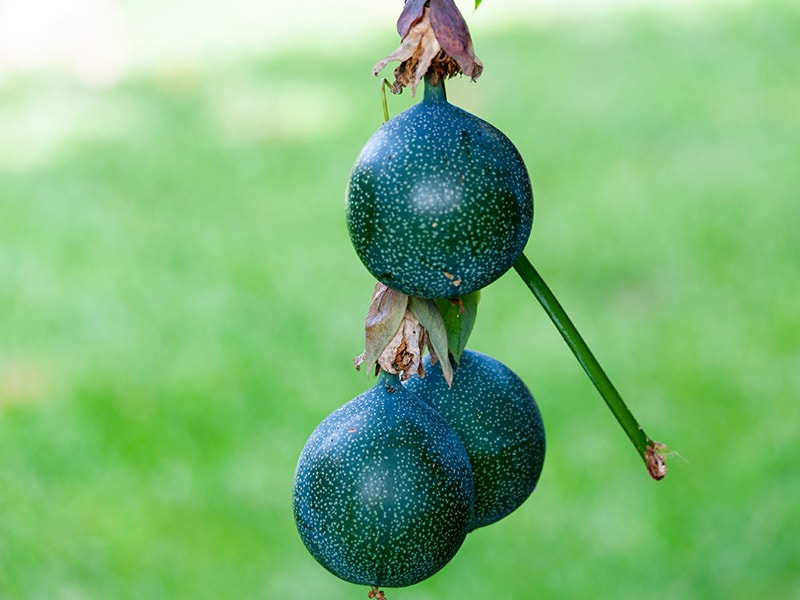
People often mistake these granadilla fruits with Maracuya or the purple-rinded passion fruits. Their appearances are indeed somewhat similar inside and out. But granadillas are usually sweet and light in color compared to the sour passion fruits.
When ripe enough to eat, they will taste pleasant and refreshing and will leave a hint of honey on your taste buds. The rind is soft and smooth with a brittle exterior.
Throughout Central American countries like Guatemala, this sweet granadilla tree is one of the most common fruit trees that the locals have cultivated for a long time. This species, whose scientific name is Passiflora ligularis, is very popular at marketplaces in the cities of Guatemala.
Season: You can taste the juiciest granadillas in spring when traveling to Guatemala.
Healthy nutrients: This fruit will provide you with calcium, iron, protein, and fiber.
How to eat: Cut the fruit in half and eat the inside with a spoon. People also use Granadilla to mix in with orange or tangerine juice.
This is the experience of tasting granadillas in Guatemala.
5. Mamoncillo/Quenepas/Guinepas (Spanish Lime)
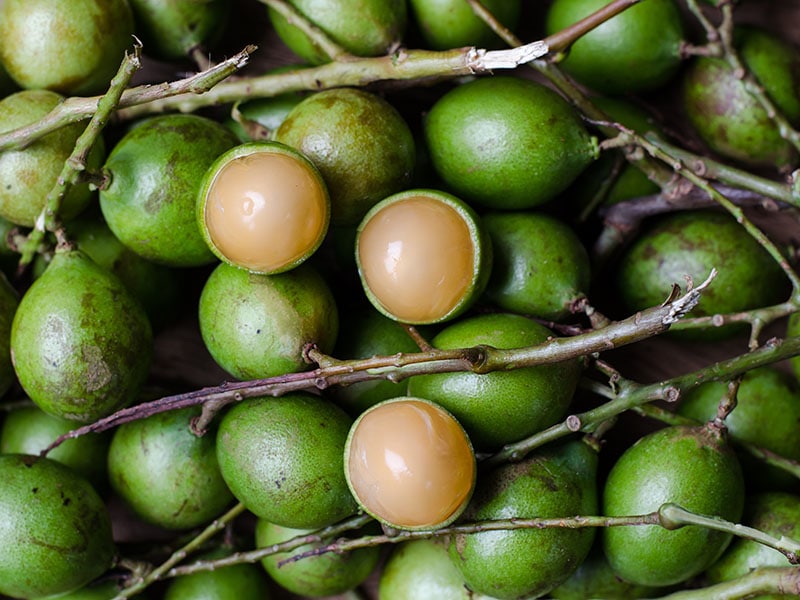
This drupe fruit is very famous in many regions of the Americas. In Guatemala, they go by several names like Mamoncillo, Quenepas, or mamons.
Although people generally call it Spanish lime, the flesh does not taste nor look like that of lime at all. When cutting into a Mamoncillo, you will see a yellowish glossy flesh that has a taste similar to lychee. This is far different from the citrusy sour flavor of limes that you normally experience.
When in Guatemala, you will often see that vendors usually sell them on branches in a whole bunch. And if you want to look for good and tasty Mamoncillos, look for those that are firm to the touch. Make sure to avoid the bruised Mamoncillos.
Season: Widely available in Guatemala in summer. (July – August)
Healthy nutrients: Vitamin A, fiber, calcium, phosphorus.
How to eat: Peel the skin and eat the flesh. Don’t forget to get rid of the big seed underneath the flesh. And remember that the juice can stain your clothes.
6. Pitaya/Pitahaya (Dragon Fruit)
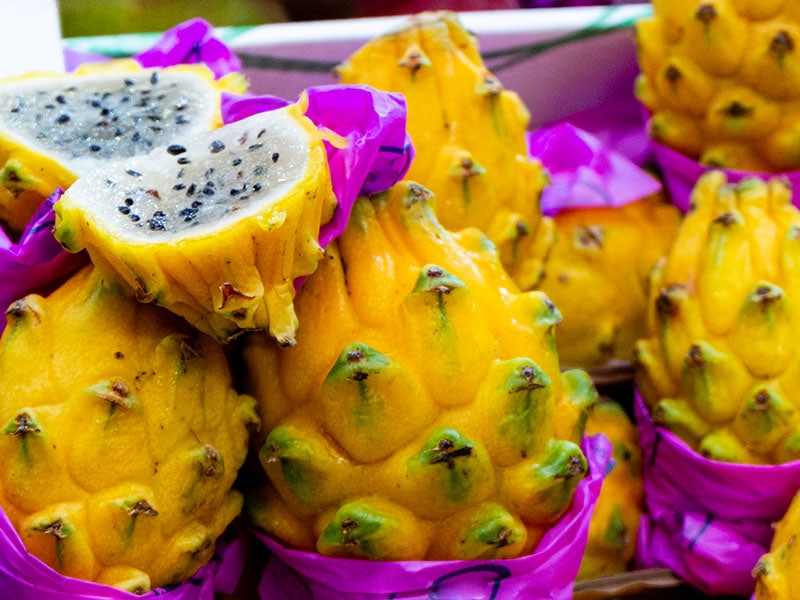
Pitaya, also known as dragon fruit, is a fruit tree of the Cactaceae family. It’s widely common in Australia, Southeast Asia, and the Americas.
From its English name, you can already tell why people give the fruit such a name. Pitaya has a scaly outer layer that resembles the skin of a dragon. There are a few varieties of Pitaya, and each of them has a different flesh color.
Pitaya Blanca is the most common variety with white flesh and red rind. The next variety that Guatemalans love for its natural sweetness and beautiful pink shade is the Pitaya Roja. You can also recognize a variety called Pitaya Amarilla from the yellow rind.
This variety has a bright yellow facade. The flesh, unlike the other two varieties, is a shade of translucent white with larger yet fewer seeds. Among all three varieties, Pitaya Amarilla tastes the sweetest.
Season: You can find some enjoyable and juicy Pitaya in Guatemala from June to November.
Healthy nutrients: Dragon fruit offers a wide variety of nutrients like Vitamin C, calcium, and prebiotics.
How to eat: Cut the fruit in half before slicing the flesh in sections to enjoy. You can eat directly from the fruit or use a spoon for a mess-free fruit feast.
7. Piñuela
At first sight, almost every single foreigner is fooled by the flower-like appearance of the Piñuela fruit in Guatemala. A closer look and a taste test are the only things that will help you distinguish this interesting-looking fruit from a plant called Bromelia Karatas.
Piñuelas are fruits similar and related to pineapples. Much like pineapples, this fruit can sting your tongue if you decide to eat too many of them. Nevertheless, the taste of it is sensational. When biting into it, you will feel a sweet taste with an acidic note from the interior.
Piñuelas usually come in a layer of dark covering the whole fruit. To enjoy them, you have to brush off the hair and peel the hardcover. In addition to that, you should be extra careful with the hair layer as this layer will sting your outer and inner lips once contacting the area.
Season: You can find an abundance of Piñuelas in Guatemala from early summer to early fall.
Healthy nutrients: Piñuelas are rich in vitamin C, calcium, and fiber.
How to eat: Can be eaten raw, although Guatemalans usually cook these in campfire embers before enjoying.
8. Zapotey Mamey/Sapotey Mamey
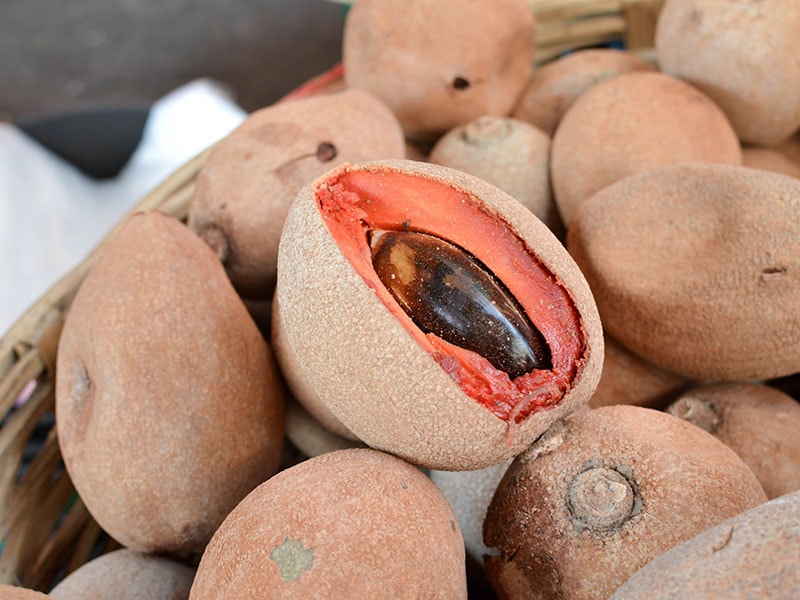
Usually, you would think fruits are juicy and a little sweet and sour, but Zapotey Mamey is a kind of fruit that will prove otherwise. This is a fruit that’s very common in the Caribbean and Central American countries, including Guatemala.
Underneath the brown, slightly hairy, and leathery skin, you will find a ripe and beautiful salmon-colored flesh that’s creamy and sweet. The texture of this fruit is so smooth that it would feel like cream against your palate.
Ripe Zapotey Mamey will remind you of honey and almond as its sweetness is extremely pleasant. You will also notice how these fruits will start to spread their fragrance once they have finished riping.
Season: November to March is an ideal time to look for Zapotey Mamey in Guatemala.
Healthy nutrients: Protein, vitamin B6, and copper.
How to eat: Cut the fruit in half like you would with avocados. Rid the fruit of the seed and scoop the flesh with a spoon to eat.
Sapote Mamey directly from Guatemala is something you should not miss.
9. Misperos/Nisperos (Loquat)
The Mispero fruit, also known as the loquat, is Guatemalans’ favorite for its perfect balance of sweetness and acidity. During its season, people enjoy eating Nisperos fresh. This tastes especially good in fruit cups and salads.
Green Nisperos are the best ingredients for desserts like tarts and pies. Guatemalan people also cook this type of fruit in syrup when it’s ripe. This makes a great batch of jam. Making jelly and chutney from this kind of fruit are also great ways to preserve the fruit.
There is a phrase that Guatemalans use, which is “Cosecha”. This is the phrase to talk about the peak of Nisperos harvest time, which is November.
Season: Misperos are available from October through December.
Healthy nutrients: Nisperos is full of fiber, magnesium, and provitamin A.
How to eat: Peel the skin and eat the flesh around the seeds. You can also slice the fruit in half and scoop out the flesh. Nisperos is a great ingredient to make tea or as a snack.
10. Sapodilla
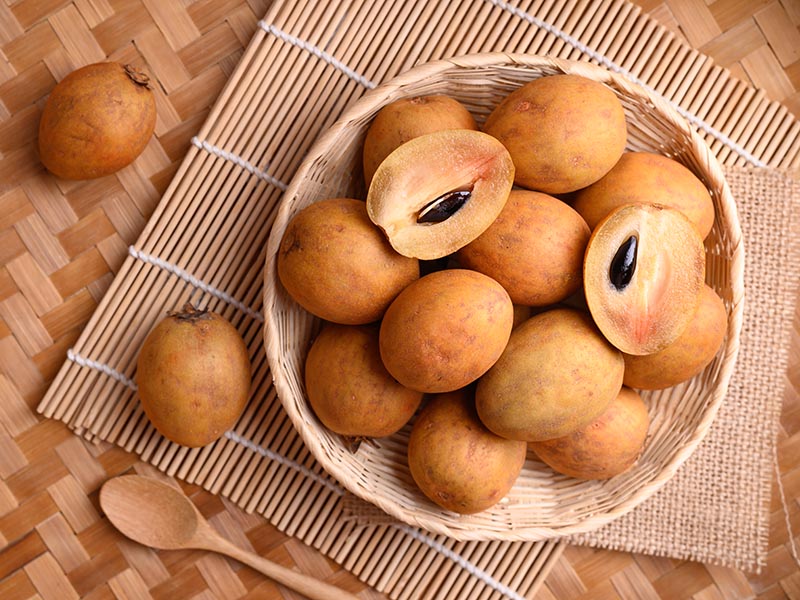
Nispero comes in different shapes and colors, each version with its unique appearance. These fruits are similar to pears in shape, with dark orange skin. The fruit has a sweet and tart flavor that is a combination of citrus, peach, and mango. It is the sweetest when ripe.
The two most common varieties of Nisperos in Guatemala are Alagarda Nispero and Redonda Nispero. Guatemalans usually harvest Algar Nisperos around October, and the fruits are sweeter around this time. This makes the Algar variety perfect for people to enjoy fresh.
Season: from October to December
Healthy nutrients: Vitamin B1, vitamin B2, iron, and calcium.
How to eat: You can eat the fruit right from the skin, but remember to discard the seed.
Let’s learn a little bit about Sapodillas in this helpful guide.
11. Carambola (Star Fruit)

Throughout Guatemala, you will be able to find Carambola, even though it’s not the most well-known type. Carambola is famous for its unique shape. When cut in half, the flesh will look like a star with a beautiful opaque green color.
Ripe star fruits will turn yellow and have a sweet taste. The texture of this fruit is somewhat similar to that of apples or pears. There are seeds all over the crunchy flesh that have the shape of a star.
Despite their Southeast Asian origin, star fruits are loved throughout the cities of Guatemala and other tropical regions.
Season: There are several seasons in Guatemala that you can look for this fruit. You can either look for star fruits from April to June or from October to December.
Nutrients: Star fruits are a great source of fiber, protein, and vitamin C.
How to eat: Rinse with water and slice the fruit into slices before eating.
12. Licha (Rambutan)
Licha or Rambutan is a tropical fruit that’s recently gained its reputation in Guatemala. The fruits are full of soft spines in the shade of red. Rambutan is a rather new type of fruit in Guatemala, so many locals may not be familiar with it.
Rambutan is part of the Sapindaceae family in the soapberry family of fruits. You might know of other fruits that are in the same family, such as lychees and longans. However, the taste and texture of rambutans are vastly different.
Rambutan flesh is slightly crunchy and tastes sweet. Since rambutans are a drupe fruit, make sure you get rid of the seed underneath the flesh when eating.
Season: Rambutans are usually available in December and January, though there may be a minor harvest in the summer
Healthy nutrients: Rambutans can help with cardio health thanks to potassium. They are also rich in vitamin C.
How to eat: Break off the rind to reveal the opaque flesh, then eat the flesh but discard the seed.
13. Caimito/Pouteria Caimito (Star Apple)

Caimito or star apples are a part of the Sapote or Sapotaceae family. There are two varieties of caimito that you can find in Guatemala: crimson and green star apples. Despite its name, this fruit does not resemble apples at all.
The caimito tree gives fruits that are milky and sweet. One taste of them, and you will sense a smooth texture on your palate and a gentle taste of sweetness. The thick rind blends itself into the interior, so you need to watch out for the rind when scooping for the flesh.
Guatemalans love this fruit for its smooth texture and a taste that reminds them of a sweet sip of milk. The flesh is very juicy and very custardy.
Season: Caimito fruits are mainly available from February to June in Guatemala.
Healthy nutrients: This fruit is high in vitamin C and rich in antioxidants.
What does the inside of a caimito fruit look like? This introduction will help you answer just that.
14. Avocados

Guatemala is the birthplace of one of the tastiest avocado varieties in the world. Various savory and sweet dishes worldwide use avocado, especially this nutty and buttery kind.
Native Guatemalan avocado trees are known for producing large, thick-skinned avocados with buttery flesh. In Guatemala, you will often hear the word “Guatemalteca” coming from vendors when talking about avocados. This is an umbrella term for different avocado varieties.
Avocado (Persea americana) is a South American subtropical fruit that has been considered the most nutritious of all fruits. It is highly recognized not just for its unique texture, wonderful flavor and nutritional profile but also for its numerous health benefits.
Season: Avocados are mostly harvested starting from April through June in Guatemala.
Healthy nutrients: Avocados contain healthy fatty acids like omega-3, vitamin C, and vitamin B6.
How to eat: Cut the fruit in half along the pit and use a spoon to scoop out the pit. Eat the avocado raw or top it onto a salad or smear it onto a slice of bread.
15. Manga/ Mangó (Mango)
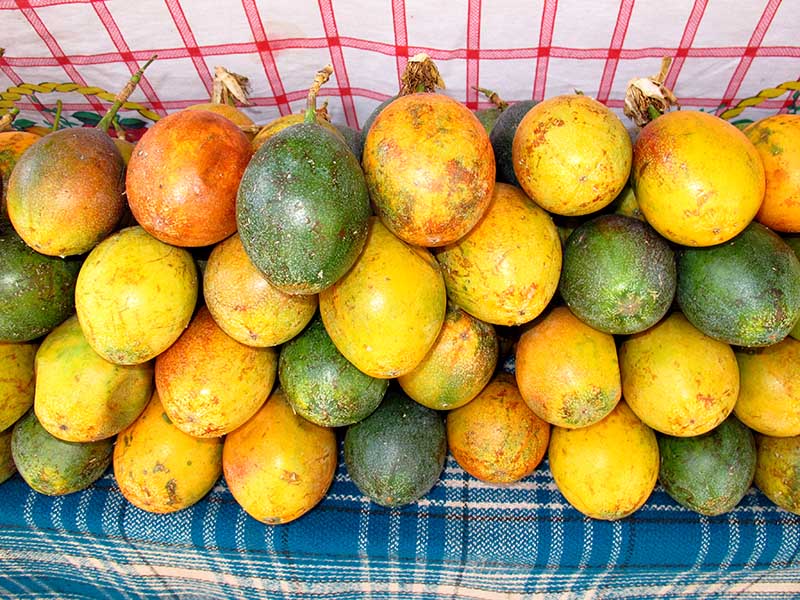
Of all the mango varieties, Guatemala is a country famous for the best variety. One such variety is Mango De Leche (milk mango), which also goes by the name of Mango De Pashte (loofah mango).
As the names may have suggested, these mangoes are very juicy and tasty, each with its unique features. For Mango De Leche, the taste is gentle, and the texture is smooth. It will feel as if you’re taking a spoonful of milky goodness into your mouth.
There’s no solid evidence why it is also called Mango De Pashte. But I’m guessing it’s because of how the pit becomes hairy and fluffy after you suck onto it. The shape of the pit then somewhat resembles a loofah.
Make sure to give these fruits a try when you’re traveling to Guatemala. You will be impressed with how juicy and succulent they are. After all, enjoying a tropical fruit in a tropical country will certainly give you a more complete experience.
Season: Mangos in Guatemala taste best around May to August and around mid-September to October.
Healthy nutrient: Mangos are low in calories and high in minerals. They also contain vitamin C and B6.
How to eat: Slice the mango in half and slice the flesh into chunks to eat. You can pair the mangos with ice cream, or yogurt, or use them as a salad topping.
3 Fruits Available All Year Round And At Other Times in Guatemala
There are fruits that you can find in Guatemala at almost any time of the year. They have a very welcoming flavor, meaning you can enjoy them at any given time, on their own or as a topping.
16. Curuba (Banana Passionfruit)

Curuba is another fruit in the passion fruit family. This fruit will offer a less acidic taste than that of the regular circular passionfruit. Today, you can find banana passionfruit in many Latin American countries, such as Venezuela, Peru, Bolivia, and, of course, Guatemala.
When cutting this long oval fruit in half, you will find a center of yellow flesh full of seeds underneath the smooth and leathery skin. When tasting Curubas, you will notice a tropical citrus flavor with a nectarine-like taste.
This kind of fruit makes a great flavoring agent for beverages. In many American countries, including Guatemala, it’s common to see people strain the flesh from the seeds and add it into sodas, juice, or smoothies. The flesh of Curubas will give a more flavorful taste to special Guatemalan drinks.
Season: Curubas are usually abundant all year round, the peak season starts in the spring.
Healthy nutrients: Curubas contain many nutrients like calcium, iron, phosphorus, potassium, and fiber.
How to eat: Slice the fruit in half, and use a spoon to enjoy its pulp on its own. You can also pour on yogurt or ice cream or mix it into a salad. The seeds are also edible.
17. Fruta Bomba/ Papaya

These papaya fruits are common in the Central American region, especially along the Caribbeans. The Guatemalan varieties are usually very large and have a bright reddish-orange color.
Papaya is sweet and silky to the taste; it will somewhat remind you of the flavor of melons. The flesh contains papain, an enzyme that enhances digestion. The taste of this fruit gets sweeter as it ripens.
You are more likely to encounter ripe papaya fruits than unripe ones. The ripe fruits will give a buttery mouthfeel as it melts on your tongue. Unripe papayas, on the other hand, don’t smell too pleasant. That’s why most Guatemalans wait until the fruits reach the right ripeness to eat.
Season: All year-round.
Nutrients: Papaya is a good source of lycopene and cryptoxanthin.
How to eat: Slice the fruit in half and scoop out the seeds. Slice or cut the flesh into chunks and eat them fresh. You can also blend the fruit into a smoothie or a Licuados, a Guatemalan kind of smoothie that’s lighter in texture.
18. Paterna (Ice Cream Bean)
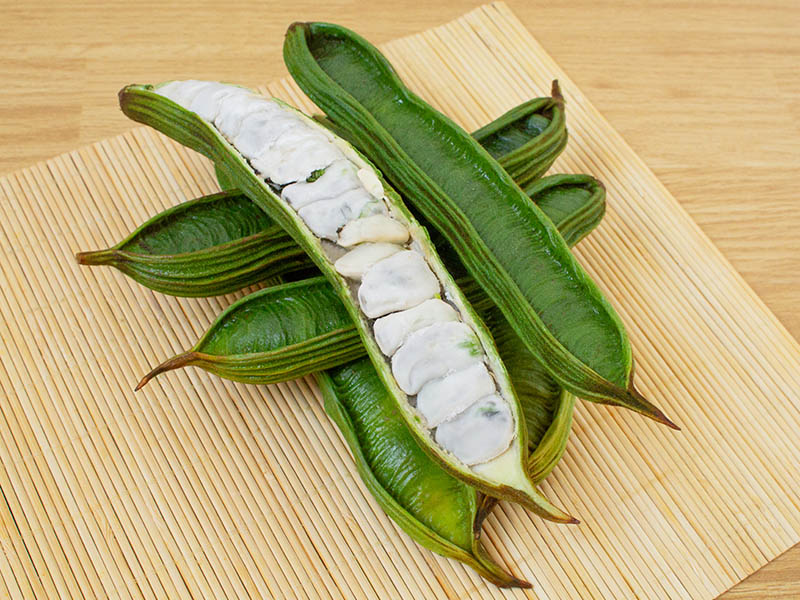
Paterna or Inga Edulis is a fruit famous in the Americas, Guatemala included. It comes from a fast-growing tree called Inga edulis. Paterna also goes by Guaba, Guama, or Guama De Bejuco.
Although the flesh is edible, make sure to stay away from the seeds as these are extremely bitter. When eating these ice cream beans, a new sensation will flood into your palate as these fruits are similar to cotton candy in texture.
The taste is said to be similar to vanilla ice cream. There are also varieties with flavors slightly like that of cinnamon. The seeds from this fruit are edible and taste somewhat like chickpeas, but they have to be cooked first.
You will see that the locals in Guatemala use this fruit and the tree for many purposes. It can be used for making food, medicine, and alcoholic beverages, and the trees are used for shades and woods.
Season: All year round
Healthy nutrients: Ice cream beans contain nutrients like vitamin A, vitamin B, vitamin C, and protein.
How to eat: Crack the pod open, and you will see the cotton-like pulp. Eat the pulp and discard the seeds.
Any Fruits You’re Determined To Try Next Time You’re In Guatemala?
Some of these Guatemalan fruits are easily accessible elsewhere in the world. However, there are indeed some of them that require traveling to its native land to try. Thus, you can always make use of your traveling to have a taste of these wonderful fruits.
I would love it if you could share with me your experience tasting these fruits? Anything other readers need to look out for when trying these out? Also, it would mean a lot if you could give this post a share. The more the merrier, don’t you agree? Enjoy your fruits, and thank you!



Linda Dean
Expertise
Culinary Arts, Food Journalism, Global Cuisine, Exploration, Recipe Development, Cultural Food Studies, Culinary Travel and Storytelling
Education
Culinary Institute of America, Hyde Park, NY
Program: Associate in Culinary Arts
Focus: Developed a comprehensive understanding of global cuisines and essential cooking techniques. Engaged in intensive hands-on practice in both kitchens and real-world settings, guided by expert chefs. This program emphasized the application of culinary skills in professional environments, preparing students for a variety of roles in the culinary industry.
City, University of London, London, UK
Program: BA Journalism
Focus: Gained expertise in media studies with a strong foundation in reporting, editing, and communicating. While the program focuses broadly on journalism, the skills acquired apply to food journalism, including the ability to analyze and report on food culture and culinary trends effectively.
Linda Dean is an experienced chef and food writer who loves exploring flavors from around the world. Trained at the Culinary Institute of America, Linda has spent over ten years mastering the art of making dishes that truly represent different cultures. She also studied journalism at City, University of London, which helps her write engaging stories about these foods.
On heythattastesgood.com, Linda shares recipes that bring the world’s kitchens to her readers. She focuses on authentic tastes and the stories behind them, making it easy for anyone to try international cuisine at home.